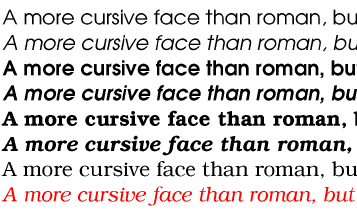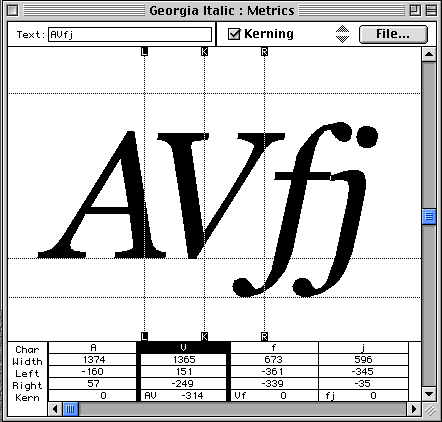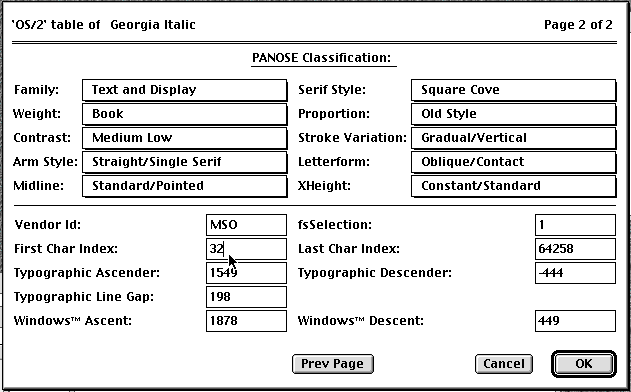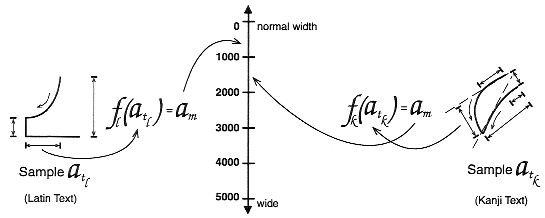Appendix C. Implementation and performance
notes for fonts
This appendix is informative, not normative.
- DocLock™
- Bitstream's DocLock™ technology ensures that TrueDoc
PFRs can only be used with the site they are published for. A TrueDoc
PFR moved to a different site or referenced from another site will not
work.
- Digital Signature
- Part of a trust management technology, used to provide signed
assertions about a resource.
- Font Caching
- Font caching allows for a temporary copy of fonts on the client
system. They are often stored on disk with other cached items such as
graphics specifically for the UA.
- Font Face
- A "handle" that refers to a specific face of a font, excluding
the font size.
- Font Matching
- Font matching is a process of selecting a similar font based
on using one or more attributes of the primary font. Common attribute include
serif, sans-serif, weight, cap height, x-height, spacing, language, and
posture. Font matching is dependent on the algorithm and the variety of
candidate fonts.
- Glyph Representation Sub-setting
- Glyph Representation sub-setting is the process by which
unwanted glyph representations (together with their side bearings and
kerning information) are removed from a primary font to produce a
smaller subset font that covers a particular document or set of
documents. This is a particular win for documents that use ideographic
scripts, where the glyph complement of the base font can be very
large. Glyph representation sub-setting for documents using scripts
that require ligatures, such as Arabic, is difficult without knowing
the ligature formation rules of the final display system.
- Intellifont
- Intellifont technology was developed by Agfa and is the native
format for Hewlett-Packard and other printers that use the PCL5
language. It is also the native font format on the Amiga
computers.
- Infinifont
- A font synthesis technique which, given a Panose-1 number (and,
optionally, additional font description data) can generate a faux font
without extrapolating from a single master outline or interpolating
between two or more outlines (see [INFINIFONT]).
- Italic
- A class of letter forms for Latin scripts, that are more cursive
than roman letter forms but less so than script forms. Often, a pair of
fonts are designed to be used together; one is a serifed roman and one
is italic. Other terms to describe this class of letter forms include
cursive and, for Cyrillic scripts, kursiv. For sans-serif faces, the
companion face is often a slanted or oblique variant rather than a
different class of letter form.
 [D] [D]
- Kerning
- Altering the spacing between selected glyph representations, which
would otherwise appear to be too close or too far apart, to obtain a
more even typographical color.
 [D] [D]
- Multiple Master Font
- A Multiple Master Font contain two primary fonts that are used
with special rendering software to provide an interpolated result. Adobe
Systems provides a mechanism that allows for parameters to be used to control
the output or the interpolated output font. These parameters generally describe
the characteristics of an original font and the multiple master result
is referred to as a "synthesized font."
- Open Type
- Open Type is an extension to the TrueType font format that
contains additional information that extends the capabilities of the
fonts to support high-quality international typography. Open Type can
associate a single character with multiple glyph representations, and
combinations of characters with a single glyph representation
(ligature formation). Open Type includes two-dimensional information
to support features for complex positioning and glyph attachment.
TrueType Open and OpenType contain explicit script and language
information, so a text-processing application can adjust its behavior
accordingly (see [OPENTYPE]).
- Server Font
- A Server Font is a font resource located on the web server
that is referenced by the WebFont definition. The user agent may use
this resource for rendering the page.
- Speedo
- Speedo font technology was developed by Bitstream and is
the native font format on the Atari ST and Falcon computers. It is
also used by computers running the X window system.
- TrueDoc
- TrueDoc technology was developed by Bitstream for the
creation, transport, and imaging of platform independent scalable
font objects on the web. Creation of font objects is done by the
TrueDoc character shape recorder (CSR) and the rendering of the font
objects is done by TrueDoc's character shape player (CSP). The
technology is intended to be used on the web for viewing and
printing.
- TrueDoc Portable Font Resource
- A TrueDoc Portable font resource (or, PFR) is a
platform-independent scalable font object that is produced by a
character shape player. Input may be either TrueType or Type 1 of any
flavor on either Windows, Mac, or Unix. TrueDoc Portable Font
Resources provide good compression ratios, are platform
independent, and because they are not in an native font format
(TrueType or Type 1) they can not be easily installed.
- TrueType
- TrueType is a font format developed by Apple and licensed
to Microsoft. TrueType is the native operating system font format for
Windows and Macintosh. TrueType contains a hierarchical set of tables
and glyph representations. Characters can be hinted on a per
character and point size basis yielding excellent quality at screen
resolutions. TrueType fonts for Windows and Mac have few differences,
though they can be different enough to prevent cross platform
usage.
- TrueType Collection
- A TrueType Collection (or TTC) is an extension to
the TrueType format that includes tables that allow for multiple
TrueType fonts to be contained within a single TrueType font file.
TrueType collection files are relatively rare at this time.
- TrueType GX Fonts
- TrueType GX Fonts contain extensions to the standard
TrueType format that allow for mutable fonts, similar to Multiple
Master fonts. There may be several mutation axis such as weight,
height, and slant. The axis can be defined to obtain almost any
effect. TrueType GX can also supports alternate glyph representation
substitution for ligatures, contextual forms, fractions, etc. To date,
TrueType GX is available only on the Mac (see [TRUETYPEGX]).
- Type 1 font
- Type 1 fonts, developed by Adobe Systems, were one of first
scalable formats available. Type 1 fonts generally contain 228
characters with the glyph representations described using third degree
bezier curves. Mac, Windows, and X have similar but separate formats;
Adobe provides Adobe Type Manager for all three platforms. Type1c is a
more recent losslessly-compressed storage form for Type 1 glyph
representations.
- URI Binding
- A process of locking a particular font resource to a given Web
site by embedding an encrypted URI or a digitally signed usage
assertion into the font resource.
There are many different font formats in use by many different
platforms. To select a preferred font format, transparent content
negotiation is used (see [NEGOT]). It is always possible to
tell when a font is being dereferenced, because the URI is inside a
font description. A given implementation will know which downloadable
font formats it supports and can thus use the format hint to avoid
downloading fonts in an unsupported format.
 [D] [D]
The Family, Serif Style and Proportion numbers are used by
Windows95 for font selection and matching.
The meaning of the ten numbers and the allowable values (given in
parentheses) are given below for the most common case, where the "family"
digit is 2, Text and Display. (If the first digit has a different
value, the remaining nine digits have different meanings). For further
details on Panose-1, see [PANOSE].
- Family
-
- Serif Style
- Any (0)
- No Fit (1)
- Cove (2)
- Obtuse Cove (3)
- Square Cove (4)
- Obtuse Square Cove (5)
- Square (6)
- Thin (7)
- Bone (8)
- Exaggerated (9)
- Triangle (10)
- Normal Sans (11)
- Obtuse Sans (12)
- Perp Sans (13)
- Flared (14)
- Rounded (15)
- Weight
- Any (0)
- No Fit (1)
- Very Light (2)[100]
- Light (3) [200]
- Thin (4) [300]
- Book (5) [400] same as CSS1 'normal'
- Medium (6) [500]
- Demi (7) [600]
- Bold (8) [700] same as CSS1 'bold'
- Heavy (9) [800]
- Black (10) [900]
- Extra Black / Nord (11) [900] force mapping to CSS1 100-900 scale
- Proportion
- Any (0)
- No Fit (1)
- Old Style (2)
- Modern (3)
- Even Width (4)
- Expanded (5)
- Condensed (6)
- Very Expanded (7)
- Very Condensed (8)
- Monospaced (9)
- Contrast
- Any (0)
- No Fit (1)
- None (2)
- Very Low (3)
- Low (4)
- Medium Low (5)
- Medium (6)
- Medium High (7)
- High (8)
- Very High (9)
- Stroke Variation
- Any (0)
- No Fit (1)
- No Variation (2)
- Gradual/Diagonal (3)
- Gradual/Transitional (4)
- Gradual/Vertical (5)
- Gradual/Horizontal (6)
- Rapid/Vertical (7)
- Rapid/Horizontal (8)
- Instant/Horizontal (9)
- Instant/Vertical (10)
- Arm Style
- Any (0)
- No Fit (1)
- Straight Arms/Horizontal (2)
- Straight Arms/Wedge (3)
- Straight Arms/Vertical (4)
- Straight Arms/Single Serif (5)
- Straight Arms/Double Serif (6)
- Non-Straight Arms/Horizontal (7)
- Non-Straight Arms/Wedge (8)
- Non-Straight Arms/Vertical 90)
- Non-Straight Arms/Single Serif (10)
- Non-Straight Arms/Double Serif (11)
- Letterform
-
- Any (0)
- No Fit (1)
- Normal/Contact (2)
- Normal/Weighted (3)
- Normal/Boxed (4)
- Normal/Flattened (5)
- Normal/Rounded (6)
- Normal/Off Center (7)
- Normal/Square (8)
- Oblique/Contact (9)
- Oblique/Weighted (10)
- Oblique/Boxed (11)
- Oblique/Flattened (12)
- Oblique/Rounded (13)
- Oblique/Off Center (14)
- Oblique/Square (15)
- Midline
-
- Any (0)
- No Fit (1)
- Standard/Trimmed (2)
- Standard/Pointed (3)
- Standard/Serifed (4)
- High/Trimmed (5)
- High/Pointed (6)
- High/Serifed (7)
- Constant/Trimmed (8)
- Constant/Pointed (9)
- Constant/Serifed (10)
- Low/Trimmed (11)
- Low/Pointed (12)
- Low/Serifed (13)
- XHeight
- Any (0)
- No Fit (1)
- Constant/Small (2)
- Constant/Standard (3)
- Constant/Large (4)
- Ducking/Small (5)
- Ducking/Standard (6)
- Ducking/Large (7)
Panose-2 (see [PANOSE2]) is a specification for a
more comprehensive font classification and matching technology which
is not limited to Latin typefaces. For example, the serif
characteristics of a Latin face may be compared with the stroke
terminations of a Kanji face.

The Panose-2 value is not stored inside any known font formats, but
may be measured.
This information is available in the font by looking at the
'ulUnicodeRange' bits in the 'OS/2' table (if it has one), which holds
a bitfield representation of the set. This table is defined in
revision 1.66 of the TrueType specification, from
Microsoft. Considering this information as a set, each element
corresponds to a Unicode 1.1 character block, and the presence of that
element in the set indicates that the font has one or more glyph
representations to represent at least one character in that block. The
set has 128 elements as described below. The order generally follows
that in the Unicode 1.1 standard. This table may be used to convert
the information in a TrueType font into a CSS 'unicode-range'
descriptor.
|
|---|
| Block | Add | Block name | Unicode range
|
|---|
|
|---|
| 0 | 1 | Basic Latin | U+0-7F
| | 1 | 2 | Latin-1 Supplement | U+80-FF
| | 2 | 4 | Latin-1 Extended-A | U+100-17F
| | 3 | 8 | Latin Extended-B | U+180-24F
|
|
|---|
| 4 | 1 | IPA Extensions | U+250-2AF
| | 5 | 2 | Spacing Modifier Letters | U+2B0-2FF
| | 6 | 4 | Combining Diacritical Marks | U+300-36F
| | 7 | 8 | Greek | U+370-3CF
|
|
|---|
| 8 | 1 | Greek Symbols and Coptic | U+3D0-3EF
| | 9 | 2 | Cyrillic | U+400-4FF
| | 10 | 4 | Armenian | U+530-58F
| | 11 | 8 | Hebrew | U+590-5FF
|
|
|---|
| 12 | 1 | Hebrew Extended-A
Hebrew Extended-B | ?? what ranges ??
| | 13 | 2 | Arabic | U+600-69F
| | 14 | 4 | Arabic Extended | U+670-6FF
| | 15 | 8 | Devanagari | U+900-97F
|
|
|---|
| 16 | 1 | Bengali | U+980-9FF
| | 17 | 2 | Gurmukhi | U+A00-A7F
| | 18 | 4 | Gujarati | U+A80-AFF
| | 19 | 8 | Oriya | U+B00-B7F
|
|
|---|
| 20 | 1 | Tamil | U+B80-BFF
| | 21 | 2 | Telugu | U+C00-C7F
| | 22 | 4 | Kannada | U+C80-CFF
| | 23 | 8 | Malayalam | U+D00-D7F
|
|
|---|
| 24 | 1 | Thai | U+E00-E7F
| | 25 | 2 | Lao | U+E80-EFF
| | 26 | 4 | Georgian | U+10A0-10EF
| | 27 | 8 | Georgian Extended | U+10F0-10FF ??
|
|
|---|
| 28 | 1 | Hangul Jamo | U+1100-11FF
| | 29 | 2 | Latin Extended Additional | -
| | 30 | 4 | Greek Extended | U+1F00-1FFF
| | 31 | 8 | General Punctuation | U+2000-206F
|
|
|---|
| 32 | 1 | Superscripts and Subscripts | -
| | 33 | 2 | Currency Symbols | U+20A0-20CF
| | 34 | 4 | Combining Marks for Symbols | U+20D0-20FF
| | 35 | 8 | Letterlike Symbols | U+2100-214F
|
|
|---|
| 36 | 1 | Number Forms | U+2150-218F
| | 37 | 2 | Arrows | U+2190-21FF
| | 38 | 4 | Mathematical Operators | U+2200-22FF
| | 39 | 8 | Miscellaneous Technical | U+2300-23FF
|
|
|---|
| 40 | 1 | Control Pictures | U+2400-243F
| | 41 | 2 | Optical Character Recognition | U+2440-245F
| | 42 | 4 | Enclosed Alphanumerics | U+2460-24FF
| | 43 | 8 | Box Drawing | U+2500-257F
|
|
|---|
| 44 | 1 | Block Elements | U+2580-259F
| | 45 | 2 | Geometric Shapes | U+25A0-25FF
| | 46 | 4 | Miscellaneous Symbols | U+2600-26FF
| | 47 | 8 | Dingbats | U+2700-27BF
|
|
|---|
| 48 | 1 | CJK Symbols and Punctuation | U+3000-303F
| | 49 | 2 | Hiragana | U+3040-309F
| | 50 | 4 | Katakana | U+30A0-30FF
| | 51 | 8 | Bopomofo | U+3100-312F
|
|
|---|
| 52 | 1 | Hangul Compatibility Jamo | U+3130-318F
| | 53 | 2 | CJK Miscellaneous | ??
| | 54 | 4 | Enclosed CJK Letters and Months | U+3200-32FF
| | 55 | 8 | CJK compatibility | U+3300-33FF
|
|
|---|
| 56 | 1 | Hangul | U+AC00-D7FF
| | 59 | 8 | CJK Unified Ideographs | U+4E00-9FFF
|
|
|---|
| 60 | 1 | Private Use Area | U+E000-F8FF
| | 61 | 2 | CJK Compatibility Ideographs | U+F900-FAFF
| | 62 | 4 | Alphabetic Presentation Forms | U+FB00-FB4F
| | 63 | 8 | Arabic Presentation Forms-A | U+FB50-FDFF
|
|
|---|
| 64 | 1 | Combining Half Marks | U+FE20-FE2F
| | 65 | 2 | CJK compatibility Forms | U+FE30-FE4F
| | 66 | 4 | Small Form Variants | U+FE50-FE6F
| | 67 | 8 | Arabic Presentation Forms-B | U+FE70-FEFF
|
|
|---|
| 68 | 1 | Halfwidth and Fullwidth Forms | U+FF00-FFEF
| | 69 | 2 | Specials | U+FFF0-FFFD
|
Authoring tools should allow style sheet authors to add and edit font descriptors. In some cases, however, authoring tools can help by examining locally installed fonts and automatically generating descriptors for fonts referenced in the style sheet. This is also a function that can be carried out by tools which subset or convert fonts ready for dynamic download.
This table suggests where such information can be found, for common font formats.
| Descriptor | Type 1 | TrueType and OpenType | TrueType GX [TRUETYPEGX] |
| 'ascent'
| 'Ascender' in AFM/PFM file | 'Ascender' in
'hhea' table or (preferably)
'sTypoAscender' in 'OS/2' table | 'horizontalBefore' in 'fmtx' table
| | 'baseline'
| | | bsln table, see note
| | 'bbox'
| FontBBox, font dictionary | 'xMin', 'xMax', 'yMin' and 'yMax'
entries of the 'head' table
|
| | 'cap-height'
| CapHeight in AFM/PFM file | |
| | 'descent'
| 'Descender' in the AFM/PFM file. | |
| | 'mathline'
| | | bsln table
| | 'font-family'
| FamilyName, fontinfo dictionary | name table |
| | 'stemh'
| StdHW, private dictionary of AFM/PFM file | |
| | 'stemv'
| /StdVW, private dictionary | cvt table |
| | 'topline'
| | | bsln table
| | 'unicode-range'
| cmap file | OS/2 table, see Appendix C |
| | 'units-per-em'
| FontMatrix, font dictionary | unitsPerEm, head table. |
| | 'widths'
| | hmtx table |
|
- Within the bsln table, the
ideographic centered baseline may be used for stretches of
predominantly ideographic characters and the ideographic low
baseline is more suitable for ideographic characters in a run of
predominantly Latin, Greek or Cyrillic characters.
|